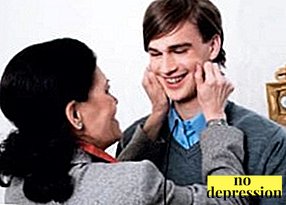A person from birth to death passes through different age periods.
There are several popular scientific approachesconsidering this issue from a social, psychological and pedagogical point of view.
Concept

Age periodization - is a classification of the level of human development, depending on his age, starting from the moment of birth and ending with death.
This indicator has not only social, psychological, but also legal value.
So, at a certain age, criminal liability comes, there is a right to represent one’s interests, the right to vote, the right to receive a pension, etc.
Any stage of human life has its own characteristics, problems and priorities. Each segment of life corresponds to a certain level of socialization, a specific mental state.
Periodization of mental development
Mental development - This is a human condition by which one can judge the level of maturity of his personality from a psychological point of view. The psychological age consists of the following components:
- Mental level (Specialists calculate the coefficient of human mental development by analyzing the results of special tests that the subject undergoes).
- Social maturity (the level of a person’s adaptation to the social reality surrounding him is determined - ability to communicate, career achievements, friendships, etc.).
- Emotional maturity (level of self-control, severity or depression of emotions, etc.).

In reality, the individual components of the psychological age of a person may absolutely not coincide with each other and with the real biological age.
Classification by year
General classification by year in the table:
Category | Age period | Features of development and communication |
Children | newborns | The birth of a child is a serious crisis for the child, since his prenatal existence stops abruptly and he finds himself in a new, unfamiliar environment. In the early infancy, the child is inextricably linked with the mother, through contact with her knows the world around us. Development occurs unconsciously, reflexively, in accordance with the genetic program laid down by nature. |
up to 1 year | Significant development of the psyche, the emergence of the first social skills - smile, laughter, contact with adults, recognition of loved ones. The mother is still of primary importance for the child, but he is already beginning to realize the possibility of her existence separately from her. | |
13 years old | There is a psychological separation of the child from the mother, the awareness of his own "I". At the age of 3, most children have a development crisis - the desire to demonstrate their independence and independence, negativism, and denial. Children often do not want to fulfill the requests of adults and tend to act in accordance with their desires. Refusal to comply with the request causes aggression. Children begin to talk, learn to play with other children. Vocabulary at this age is still limited. | |
37 years | Children comprehend the rules and regulations that exist in society. Realize what behavior is valid. Begin to actively interact with peers. Parents at this age gradually fade into the background. Vocabulary and knowledge about the world are constantly expanding. Children under 7 years of age constantly ask many questions to which they want to get answers. The child gradually loses child spontaneity. His self-esteem is formed, the inner psychic life is actively developing, his own judgments appear. | |
8 -10 years | During this period, school life takes on particular importance. The child develops logical thinking, self-discipline, the ability to control emotions. Morality is developed, basic moral principles are established, and attitudes to the laws existing in society are developed. | |
Teenagers | 11-16 years old | The most difficult period in the life of every person is when significant hormonal changes occurring in the body affect the behavior, self-esteem, relationships with peers and family. The main problem is that as a result of significant changes in the child’s appearance (development of secondary sexual characteristics), he begins to realize himself as an adult, but due to his age for a society, the teenager is still a child. The need for submission to parents, teachers often causes discontent, protest. In the first place are relationships with peers, who become the main authority. Communication skills (the ability to join the team, win friends, like the opposite sex) take on special significance. |
Young people | 17-21 year | At this age all teenage storms are left behind. Young people gain certain self-confidence, realize their interests and preferences. Finally, a picture of the perception of the surrounding world is formed, a system of moral principles is established. During this period, there is a choice of further direction of development in the social plan - the definition of a future profession. As a rule, at the same time there comes a period of the first serious relationship, the first adult love. |
Adults | 22-35 years old | Period of maturity and maximum performance. At this time, people are at the peak of their intellectual, physical, mental development. This is a period of active professional activity, the creation of a family, the birth of children. |
36-45 years old | At this time, most people already have a stable profession, family, children grow up. At the same time, the first signs of aging appear - wrinkles, gray hair, decrease in sexual and physical activity. The middle age crisis overtakes people regardless of their degree of social and mental well-being. At this time, an assessment of the stages of life, an analysis of their successes and failures takes place. Often decisions are made about the need for changes in the life of changes, about the correction of mistakes made earlier. Middle age is the time when most people have children in adolescence, and their parents are already old or dead. Difficulties in communicating with children and the need to care for elderly parents require a significant expenditure of energy. | |
46 - 60 years old | As a rule, overcoming the difficult period of middle age, people closer to the age of 60 enter a time of stability and calm self-confidence. Most of life is left behind and at this time people are beginning to truly appreciate what they have. | |
61-75 years old | For most elderly people, health problems come to the fore, because by this time all chronic diseases are exacerbated and there is a general weakness of the body. At the same time, social activity, the desire for communication, involvement in the life of the family do not weaken. Many older people continue to work, which gives them an extra incentive to live. | |
76-90 years old | Most of the old people are already retired and their area of interest is limited to their own health, socializing with the family, and caring for their grandchildren. In the elderly, the character changes significantly - it becomes less emotional, rigid. Often at this age some infantilism and egoism are manifested. Many have anxiety, insomnia, fear of death. | |
over 90 years old (long-lived) | Physical dependence, passivity, anxiety and uncertainty are actively manifested. Of great importance is the presence of a number of close people who can provide maximum assistance. The fear of death is dulled by the majority, and objective awareness of the imminent end of life comes to replace it. |
Principles and approaches
The classification is based on the assessment of the following indicators:
- chronological (the number of years on the passport);
- biological (indicators of the functioning of the body);
- psychological (mental, social and emotional development).

The basis of periodization is determining the real age of a personwhich is characterized by the above features.
At the same time, an additional analysis of the mental, biological state allows a more individual approach to the assessment of personality.
Elkonin
D.B. Elkonin was inclined to believe that the age gradation has great scientific value. Building a competent classification allows you to determine the driving forces of human development at each stage of his life.
The resulting knowledge contributes to the formation of the most complete educational system, the development of effective rules for educating the younger generation.
The scientist attached particular importance to the early stages of human life, when the basic value system is laid and the worldview is formed. Standard age phases Elkonin divided into periods:
- early childhood: infancy, early childhood;
- childhood: preschool age, primary school age;
- teenagers: younger adolescence and older adolescence.

Each period is estimated by four indicators:
- social impact - The influence of society on the formation of the child's personality;
- leading activity - type of activity that has a priority effect on mental state;
- a crisis - the negative period in the framework of each phase, which must be overcome, that go to the next level.
- neoplasms - appeared on the new stage of knowledge and skills.
Erikson
E. Erickson identified 8 stages of personality development, each of which corresponds to specific task.
According to the scientist, at each stage, when a person attains a task, priority strengths and weaknesses are manifested.
So:
- up to a year - trust or distrust;
- up to 3 years - strong will or weak will;
- from 3 to 7 - initiative or passivity;
- from 7 to 12 - self-confidence or insecurity;
- from 12 to 18 - loyalty to yourself or diffusion;
- from 18 to 25 - love or a feeling of exclusivity;
- from 25 to 65 - care or loneliness;
- from 65 - wisdom or contempt.

Vygotsky
L.S. Vygotsky paid special attention to childhood, because he believed that understanding the specifics of each stage of a child’s development gives parents the opportunity to correct their behavior and better understand the child.
The periods allocated Vygotsky:
- newborn;
- early childhood (1-3 years);
- preschool period (3-7 years);
- school age (7-; 11 years);
- puberty (15-18 years);
- youth (19-25 years old);
- youth (20-30 years);
- the boundary of youth and middle age (30-45 years) - a crisis of creative activity, caused by the formation of professional consistency at the same time as the increase in routine;
- average age (30-45 years);
- maturity (45; 60 years);
- old age (after 60 years) - a crisis of summarizing due to changes in social status, slowing down the usual rhythm of life.

Vygotsky and his periodization of the development of the psyche:
Freud
Z. Freud believed that human behavior is the result of the work of his unconscious. The main driving force is sexual energy.
The scientist identified the following stages of development of sexuality:
- Oral (up to a year). The baby gets pleasure from breastfeeding.
- Anal (1-3 years). The intestinal mucosa becomes the main erogenous zone, as the child is trained to be tidy.
- Phallic (3-5 years). The peak of child sexuality. At this time, the driving sex complexes are born - Electra and Oedipus.
- Latent (5-12 years old). Sexual development fades into the background, supplanted by social interests.
- Genital (12-18 years old). Formation of sexual aspirations.

Periodization problems
Not always the actual age of a person coincides with the level of his mental development, with the degree of socialization.
Most of the outlined boundaries can move in any direction, taking into account the characteristics of a particular person. Most vague boundaries periodization in relation to adolescence.

In any case, one period gives way to another, when the appearance of qualities and properties that were not there before.
The transition to the next stage of development and attitude automatically means a change in the period of life.
Thus, at each stage of life, man is peculiar certain features emotional, mental, intellectual development.
The question of age periodization has worried many famous scientists and continues to evoke interest in modern science.



